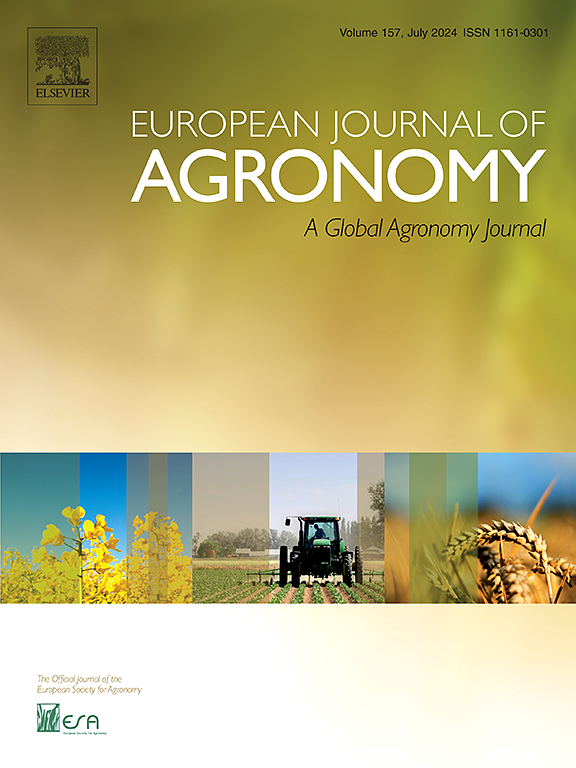The profiled parameter estimation method for dynamic systems applied to the calibration of dynamic crop growth models
IF 5.5
1区 农林科学
Q1 AGRONOMY
引用次数: 0
Abstract
Parameter estimation, model calibration, or curve fitting is a crucial stage of the development process of dynamic models that account for crop growth and development. It consists of using measured data collected from a system or process to fit model predictions. Up to now, the frequentist and the Bayesian methods have been mostly applied to the calibration of crop growth dynamic models. A new approach named profiled estimation has been developed to try to overcome the limitations of the classical parameter estimation approaches. But crop growth modelers have not applied this method yet. Thus, the objectives of this work were: i) to show that the profiled estimation procedure (PEP) can be applied to the parameter estimation of crop growth models that use ordinary differential equations and ii) to compare the performance of PEP against a frequentist parameter estimation method that used a differential evolution (DE) algorithm. As both approaches were applied to a simple maize model with three state variables and seven parameters, the PEP method performed better than the frequentist method according to RMSE, MAE, and modeling efficiency statistics. Also, a dynamic model for the growth of a lettuce greenhouse crop with three state variables and twelve model parameters was calibrated by PEP and DE. In this case, the PEP performed poorly for the calibration of more influential model parameters but acceptably in the case of the estimation of all the parameters. Still, the results from this research show that crop growth modelers should consider the PEP in the calibration of their models.
动态系统的剖面参数估计方法应用于动态作物生长模型的标定
参数估计、模型校正或曲线拟合是作物生长发育动态模型建立过程中的关键阶段。它包括使用从系统或过程中收集的测量数据来拟合模型预测。迄今为止,常用的方法主要是频率方法和贝叶斯方法。为了克服经典参数估计方法的局限性,提出了一种新的参数估计方法——剖面估计。但是作物生长建模者还没有应用这种方法。因此,这项工作的目标是:i)表明profile估计程序(PEP)可以应用于使用常微分方程的作物生长模型的参数估计;ii)将PEP与使用微分进化(DE)算法的频率参数估计方法的性能进行比较。两种方法均应用于具有3个状态变量和7个参数的简单玉米模型,从RMSE、MAE和建模效率统计数据来看,PEP方法优于frequentist方法。此外,用PEP和DE对一个具有3个状态变量和12个模型参数的生菜温室作物生长动态模型进行了校准。在这种情况下,PEP在校准更有影响力的模型参数方面表现不佳,但在估计所有参数的情况下表现良好。尽管如此,本研究的结果表明,作物生长建模者在校正模型时应该考虑PEP。
本文章由计算机程序翻译,如有差异,请以英文原文为准。
求助全文
约1分钟内获得全文
求助全文
来源期刊

European Journal of Agronomy
农林科学-农艺学
CiteScore
8.30
自引率
7.70%
发文量
187
审稿时长
4.5 months
期刊介绍:
The European Journal of Agronomy, the official journal of the European Society for Agronomy, publishes original research papers reporting experimental and theoretical contributions to field-based agronomy and crop science. The journal will consider research at the field level for agricultural, horticultural and tree crops, that uses comprehensive and explanatory approaches. The EJA covers the following topics:
crop physiology
crop production and management including irrigation, fertilization and soil management
agroclimatology and modelling
plant-soil relationships
crop quality and post-harvest physiology
farming and cropping systems
agroecosystems and the environment
crop-weed interactions and management
organic farming
horticultural crops
papers from the European Society for Agronomy bi-annual meetings
In determining the suitability of submitted articles for publication, particular scrutiny is placed on the degree of novelty and significance of the research and the extent to which it adds to existing knowledge in agronomy.
 求助内容:
求助内容: 应助结果提醒方式:
应助结果提醒方式:


